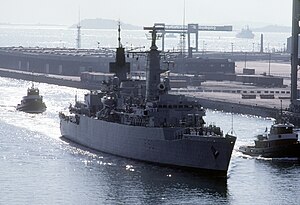HMS Brilliant (F90)
 HMS Brilliant enters a port during exercise Ocean Safari 1985
| |
| History | |
|---|---|
| Name | HMS Brilliant |
| Operator | Royal Navy |
| Builder | Yarrow Shipbuilders |
| Laid down | 25 March 1977 |
| Launched | 15 December 1978 |
| Commissioned | 15 May 1981 |
| Decommissioned | 1996 |
| Identification | Pennant number: F90 |
| Fate | Sold to Brazil 31 August 1996 |
| Name | Dodsworth |
| Operator | Brazilian Navy |
| Identification | Pennant number: F-47 |
| Fate | Scrapped |
| General characteristics | |
| Class and type | Type 22 frigate |
| Displacement | 4,400 tons |
| Length | 131.2 m (430 ft) |
| Beam | 14.8 m (48 ft) |
| Draught | 6.1 m (20 ft) |
| Propulsion |
|
| Speed |
|
| Complement | 222 |
| Armament |
|
| Aircraft carried | 2 × Lynx MK 3S helicopters |
| Aviation facilities | 1x Double Hangar with refuelling facilities |
HMS Brilliant was a Type 22 frigate of the Royal Navy.
Brilliant took part in the only ship-to-ship engagement of the Falklands War, when she and HMS Yarmouth chased the Argentine coaster Monsunen, in the Battle of Seal Cove.
Falklands War
Brilliant was part of the task force that took part in the Falklands War, with Captain John Coward in command.[1]
During the war, her two helicopters were involved in successfully attacking the
On 21 May 1982 HMS Brilliant came under Argentine air attack outside San Carlos Water and was slightly damaged by cannon fire. On 23 May she joined HMS Yarmouth in the chase of the Argentinian supply ship ARA Monsunen.
She rescued 24 survivors from
1983–1996
In 1987 she became leader of the 2nd Frigate Squadron. On 14 May 1989, the ship's helicopter, a Lynx HAS3, XZ244, crashed near Mombasa, Kenya, while en route to the city's airport for a period of shore leave. A door had detached when opened inflight and collided with the tail rotor, resulting in the aircraft splitting in half and the death of all nine personnel on board.[4]
In October 1990 she saw the first members of the
She was decommissioned from Royal Navy service in 1996 and sold to the Brazilian Navy on 31 August 1996 and renamed Dodsworth.
F47 Dodsworth was sold for scrap and broken up at Aliağa, Turkey, during July 2012.[7]
The silhouette of HMS Brilliant is painted, with the date 21 May, on the side of Argentine Air Force IAI Finger serial number C-412. Also painted on C-412 is the silhouette of HMS Arrow and the date 1 May. These kill markings (without crossing) have to do with damage to both ships in the Falklands War, HMS Arrow being slightly damaged by cannon fire 1 May 1982 and HMS Brilliant also being slightly damaged by cannon fire on 21 May. C-412's markings were painted soon after the war; they were seen during the November 2005 multi-national Exercise Ceibo in Argentina.
Citations
- ISBN 978-0-00-713467-0.
- ISBN 978-0-415-41911-6.
- ^ Ministry of Defence Page 8. Retrieved 10 March 2009
- ^ "Duke's friend one of nine Kenyan crash victims." Archived 12 October 2014 at the Wayback Machine Herald Scotland, 16 May 1989.
- ^ "History of the Women's Royal Naval Service and its integration into the Royal Navy". Archived from the original on 22 February 2014. Retrieved 31 July 2013.
- ^ Terrill 1995.
- ^ "BrNS Dodsworth F47 - ShipSpotting.com - Ship Photos and Ship Tracker". shipspotting.com. Retrieved 22 May 2020.
References
- ISBN 978-1-86176-281-8.
- ISBN 9780563371847.
- AirForces Monthly Magazine February 2006, page 61.
External links
- Argentine Aircraft Successes against British Ships
- F47 Dodsworth (in Portuguese)
